Page 22 of 319
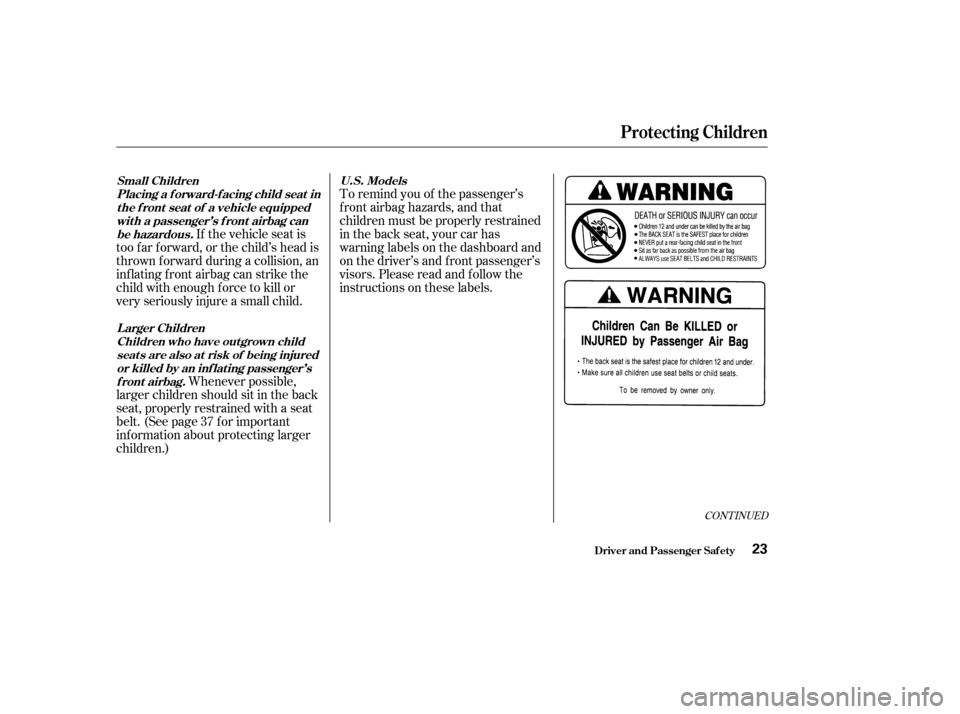
CONT INUED
To remind you of the passenger’s
f ront airbag hazards, and that
children must be properly restrained
in the back seat, your car has
warninglabelsonthedashboardand
on the driver’s and f ront passenger’s
visors. Please read and f ollow the
instructions on these labels.
Whenever possible,
larger children should sit in the back
seat, properly restrained with a seat
belt. (See page f or important
inf ormation about protecting larger
children.) If the vehicle seat is
too far forward, or the child’s head is
thrown f orward during a collision, an
inflating front airbag can strike the
child with enough f orce to kill or
very seriously injure a small child.
37
Driver and Passenger Saf ety
Protecting Children
U.S. Models
Small Children
Children who have outgrown childseat s are also at risk of being injured
or killed by an inf lat ing passenger’sfront airbag.
Placing a f orward-f acing child seat in
t he f ront seat of a vehicle equippedwit h a passenger’s f ront airbag canbe hazardous.
Larger Children
23
Page 23 of 319
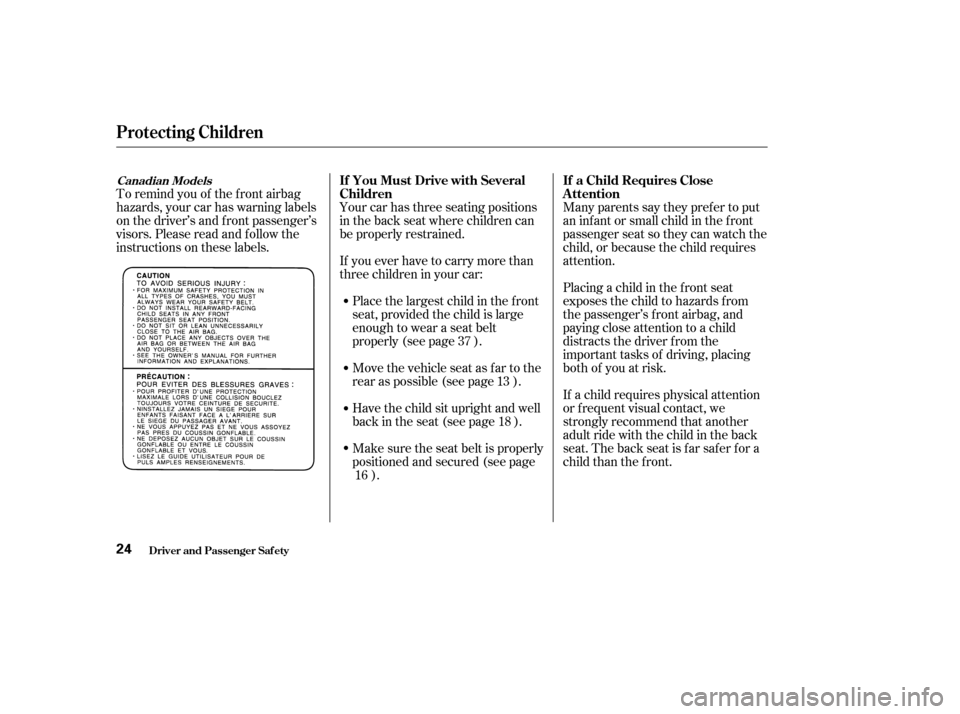
Many parents say they pref er to put
an inf ant or small child in the f ront
passenger seat so they can watch the
child, or because the child requires
attention.
Placing a child in the f ront seat
exposes the child to hazards f rom
the passenger’s f ront airbag, and
paying close attention to a child
distracts the driver f rom the
important tasks of driving, placing
both of you at risk.
If a child requires physical attention
or frequent visual contact, we
strongly recommend that another
adult ride with the child in the back
seat. The back seat is far safer for a
child than the front.
Your car has three seating positions
in the back seat where children can
be properly restrained.
If you ever have to carry more than
three children in your car:
Place the largest child in the f ront
seat, provided the child is large
enough to wear a seat belt
properly (see page ).
Move the vehicle seat as far to the
rear as possible (see page ).
Have the child sit upright and well
backintheseat(seepage ).
Make sure the seat belt is properly
positioned and secured (see page ).
To remind you of the f ront airbag
hazards, your car has warning labels
on the driver’s and f ront passenger’s
visors. Please read and f ollow the
instructions on these labels.
371318
16
Driver and Passenger Saf ety
Protecting Children
If a Child Requires Close
Attention
If You Must Drive with Several
ChildrenCanadian Models
24
Page 26 of 319
Bef ore purchasing a child seat, we
recommend that parents test the
child seat in the specif ic vehicle
seating position (or positions) where
they intend to use the seat. If a
previously purchased child seat does
not f it, you may need to buy a
dif f erent one that will f it.
Due to variations in the design of
child seats, vehicle seats, and seat
belts, all child seats will not f it all
vehicle seating positions.
A child who is too
large f or a rear-f acing child seat, and
who can sit up without support,
should be restrained in a f orward-
f acing child seat. See page f or
additional inf ormation on protecting
small children. However, Honda is conf ident that
one or more child seat models can f it
andbeproperlyinstalledinall
recommended seating positions in
your car.
34
CONT INUED
T he child seat should f it the vehicle seat ing posit ion (orposit ions) where it will be used.
Small Children: 3.
Protecting Children
Driver and Passenger Saf ety27
Page 27 of 319
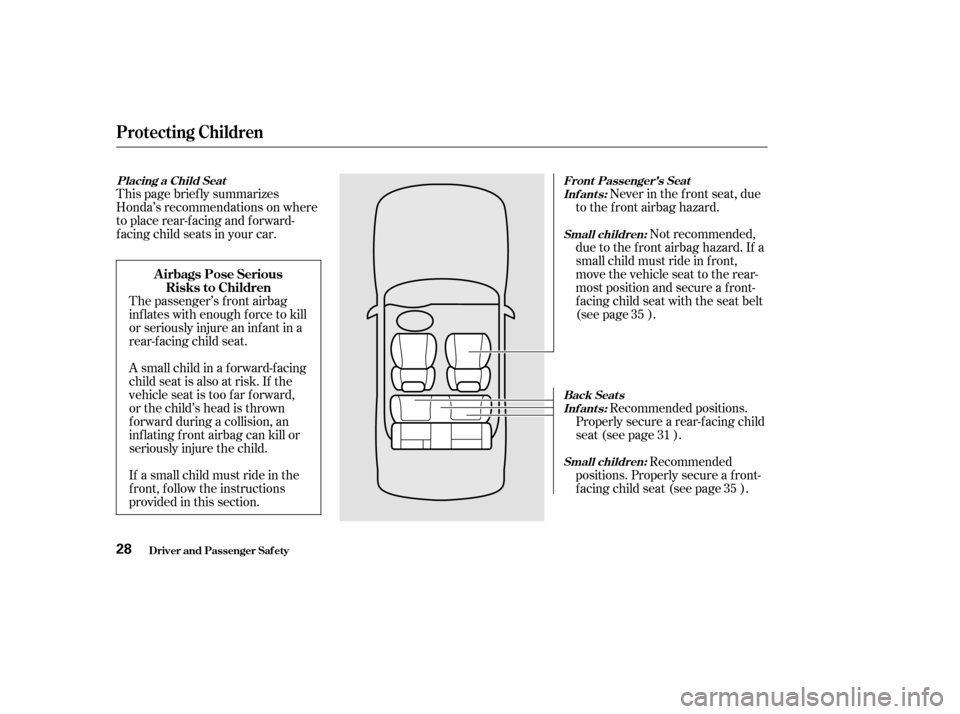
This page brief ly summarizes
Honda’s recommendations on where
to place rear-facing and forward-
f acing child seats in your car.Never in the f ront seat, due
to the f ront airbag hazard.
The passenger’s f ront airbag
inf lates with enough f orce to kill
or seriously injure an inf ant in a
rear-facing child seat.
A small child in a f orward-f acing
child seat is also at risk. If the
vehicle seat is too f ar f orward,
or the child’s head is thrown
f orward during a collision, an
inf lating f ront airbag can kill or
seriously injure the child.
If a small child must ride in the
f ront, f ollow the instructions
provided in this section. Not recommended,
due to the f ront airbag hazard. If a
small child must ride in f ront,
move the vehicle seat to the rear-
most position and secure a f ront-
f acing child seat with the seat belt
(see page ).
Recommended positions.
Properlysecurearear-facingchild
seat (see page ).
Recommended
positions. Properly secure a f ront-
f acing child seat (see page ). 35
35
31
Placing a Child Seat
Front Passenger’s Seat
Inf ant s:
Back Seat s
Small children:
Inf ant s:Small children:
Airbags Pose SeriousRisks to Children
Protecting Children
Driver and Passenger Saf ety28
Page 28 of 319
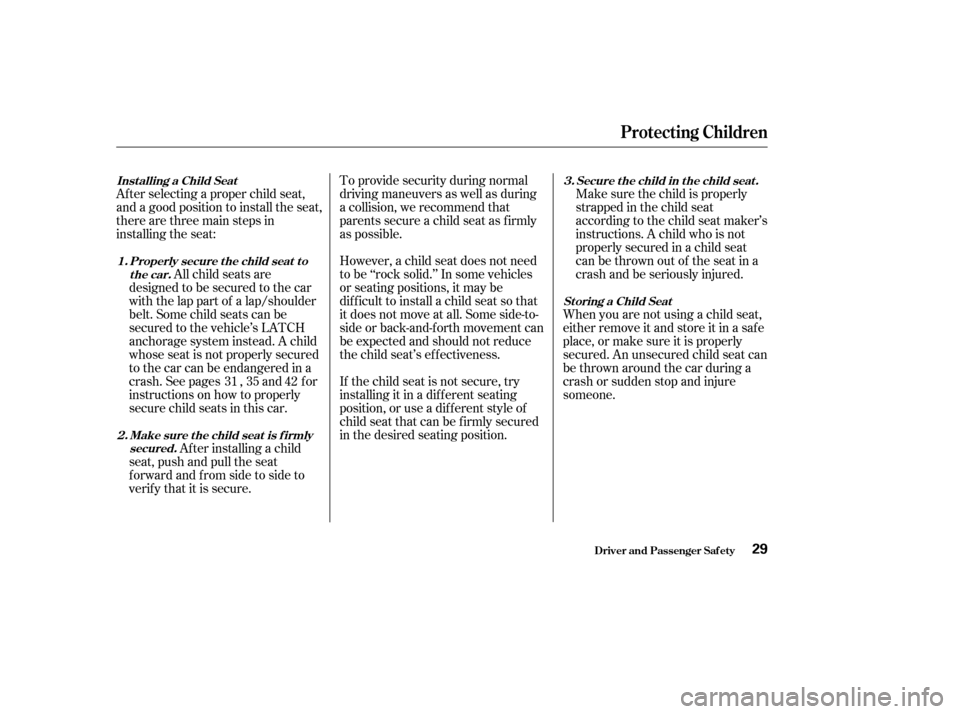
Af ter selecting a proper child seat,
and a good position to install the seat,
there are three main steps in
installing the seat:Make sure the child is properly
strappedinthechildseat
according to the child seat maker’s
instructions. A child who is not
properly secured in a child seat
canbethrownoutof theseatina
crash and be seriously injured.
To provide security during normal
driving maneuvers as well as during
a collision, we recommend that
parents secure a child seat as f irmly
as possible.
If the child seat is not secure, try
installing it in a dif f erent seating
position, or use a dif f erent style of
child seat that can be f irmly secured
in the desired seating position. When you are not using a child seat,
either remove it and store it in a saf e
place, or make sure it is properly
secured. An unsecured child seat can
be thrown around the car during a
crash or sudden stop and injure
someone.
However, a child seat does not need
to be ‘‘rock solid.’’ In some vehicles
or seating positions, it may be
dif f icult to install a child seat so that
it does not move at all. Some side-to-
side or back-and-f orth movement can
be expected and should not reduce
the child seat’s ef f ectiveness.
Af ter installing a child
seat, push and pull the seat
f orward and f rom side to side to
verif y that it is secure. All child seats are
designed to be secured to the car
with the lap part of a lap/shoulder
belt. Some child seats can be
secured to the vehicle’s LATCH
anchorage system instead. A child
whose seat is not properly secured
to the car can be endangered in a
crash. See pages , and for
instructions on how to properly
secure child seats in this car. 31 42
35
Inst alling a Child Seat Secure t he child in t he child seat .
Storing a Child Seat
Make sure t he child seat is f irmly secured.
Properly secure t he child seat t o
the car.
1.
2. 3.
Protecting Children
Driver and Passenger Saf ety29
Page 30 of 319
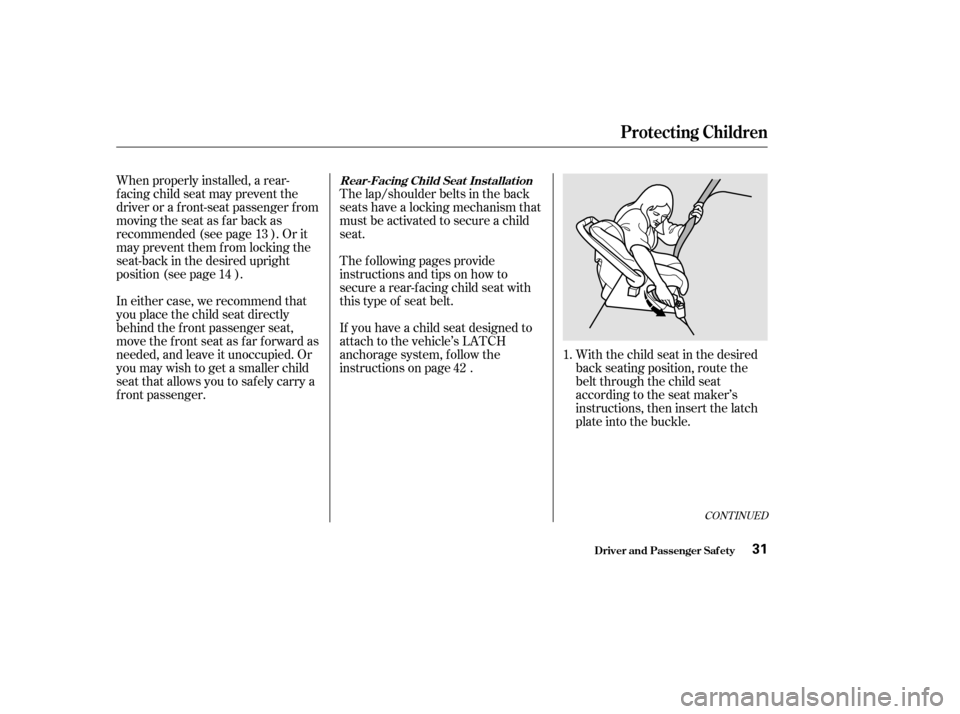
With the child seat in the desired
back seating position, route the
belt through the child seat
according to the seat maker’s
instructions, then insert the latch
plate into the buckle.
The lap/shoulder belts in the back
seats have a locking mechanism that
must be activated to secure a child
seat.
The f ollowing pages provide
instructions and tips on how to
secure a rear-f acing child seat with
this type of seat belt.
When properly installed, a rear-
f acing child seat may prevent the
driver or a f ront-seat passenger f rom
moving the seat as far back as
recommended (see page ). Or it
may prevent them f rom locking the
seat-back in the desired upright
position (see page ).
In either case, we recommend that
you place the child seat directly
behind the f ront passenger seat,
move the front seat as far forward as
needed, and leave it unoccupied. Or
you may wish to get a smaller child
seat that allows you to safely carry a
f ront passenger.
If you have a child seat designed to
attach to the vehicle’s LATCH
anchorage system, follow the
instructions on page .
1.
13
14
42
CONT INUED
Rear-Facing Child Seat Inst allat ion
Protecting Children
Driver and Passenger Saf ety31
Page 31 of 319
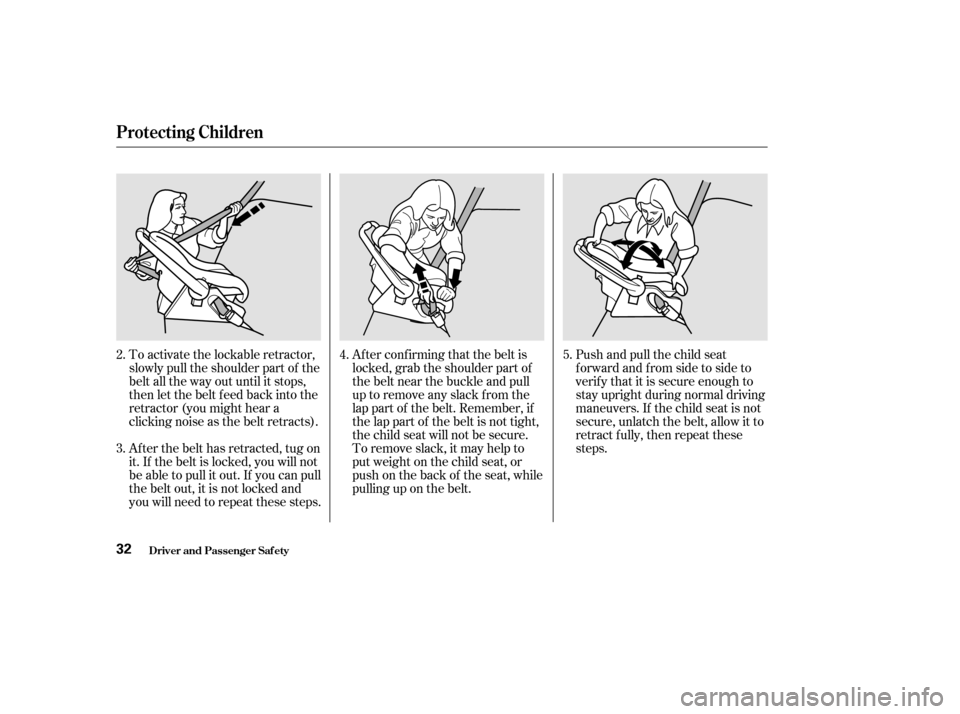
Push and pull the child seat
f orward and f rom side to side to
verif y that it is secure enough to
stay upright during normal driving
maneuvers. If the child seat is not
secure, unlatch the belt, allow it to
retract f ully, then repeat these
steps.
Af ter conf irming that the belt is
locked, grab the shoulder part of
the belt near the buckle and pull
up to remove any slack from the
lap part of the belt. Remember, if
the lap part of the belt is not tight,
the child seat will not be secure.
To remove slack, it may help to
putweightonthechildseat,or
push on the back of the seat, while
pulling up on the belt.
To activate the lockable retractor,
slowly pull the shoulder part of the
belt all the way out until it stops,
then let the belt f eed back into the
retractor (you might hear a
clicking noise as the belt retracts).
Af ter the belt has retracted, tug on
it. If the belt is locked, you will not
be able to pull it out. If you can pull
the belt out, it is not locked and
you will need to repeat these steps. 4.
5.
2. 3.
Protecting Children
Driver and Passenger Saf ety32
Page 32 of 319
Forproperprotection,aninfantmust
ride in a reclined, or semi-reclined
position. To determine the proper
reclining angle, check with the baby’s
doctor or f ollow the seat maker’s
recommendations.
To achieve the desired reclining
angle, it may help to put a rolled up
towel under the toe of the child seat,
as shown.
To deactivate the locking
mechanism and remove a child seat,
unlatch the buckle, unroute the seat
belt, and let the belt f ully retract.
Rear-Facing Child Seat Inst allat ion
Tips
Protecting Children
Driver and Passenger Saf ety33